Voice — April 2012 — To Bee or Not to Bee
or: An Un-bee-lievable Rescue Story
 By: John Becker
By: John Becker
Photos courtesy of Polly Price, all rights reserved
When VaHi residents living near the intersection of North Virginia Avenue and Stillwood Drive gathered a few weeks ago to cheer on runners in the Publix Marathon, little did they know there were a few thousand fuzzy little spectators assembling nearby with an agenda of their own.

It was around 6 PM that Sunday, in fact, when residents first noticed a large number of honeybees buzzing along the sidewalk. A little investigation revealed a large swarm of bees in the branches of a crape myrtle in front of one of the homes on North Virginia.
Fortunately, Lenox Park resident and beekeeper John Lee was just a few doors away visiting his mother-in-law at the time. He noticed the commotion on North Virginia, scrambled home to get his supplies, and the swarm rescue process was underway.
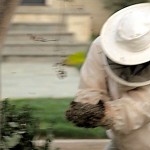
“We thought the bees had found a new place to live and that there was no urgency in moving them,” resident Polly Price says, “but when John arrived he said the bees were only resting and would most likely leave soon to find a permanent home.”
Lee’s goal was to capture the swarm, put it in a box and then find a beekeeper who could provide a long-term home for the bees. After donning his protective gear, Lee first sprayed the inside of the temporary storage box and the swarm itself with sugar water.
“Sugar water provides the bees with temporary energy,” Lee says, “and incents them to begin building the foundation for their new home. They become less concerned with anything going on outside the swarm and their main focus becomes establishing the new hive.”
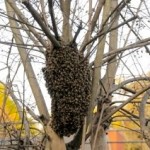
Wearing protective gloves, Lee scooped up handfuls of bees and placed them gently into the box. Price says the bees were generally willing participants in the process and that it took twenty or more handfuls to get most of the bees into the box. Toward the end of the process, Lee used a brush to capture the bees and coax them into the box. By the time darkness fell, Lee had captured most of the bees. He left the secured box by the base of the tree overnight and, as he expected, most of the remaining bees had crawled inside in search of the queen when he returned the next day.
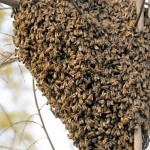
“It was a fairly large swarm – probably 10-15,000 bees – and I wanted to make sure we captured as many as possible,” Lee says.
Having watched a similar process take place across the street from my own home recently, I wanted to find out what this bee-swarming thing was all about. My across-the-street neighbor – also a beekeeper – put me in touch with Linda Tillman with the Metro Atlanta Beekeeper’s Association (MABA). Tillman says swarming is one of two ways bees reproduce.
“Within the hive, reproduction takes place individually as the queen is constantly laying eggs and producing new bees,” Tillman says. “The second form of reproduction is swarming, which is essentially the entire ‘bee community’ splitting itself in half.”
According to Tillman, the hive prepares for swarming by creating queen cells so as not to leave the original hive queen-less. While half the bee population stays in the old hive, a new queen takes the other half – mostly younger bees – with her to find a new home. Before leaving the hive, Tillman says, the bees “pack their bags for the trip” by filling their stomachs with honey. The bees use the stored honey to create wax to build their new hive.
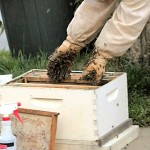
“Then one day – typically between 10 AM and 2 PM – the queen leaves the hive,” Tillman says. “She doesn’t go far and the rest of her crew joins her in a mass of bees which hang together in a clump while they seek out a new home, a process that could take several days. Scout bees are sent out from the swarm and eventually a collective decision is made as to where the new hive will be established.”
Tillman says if a beekeeper learns of a swarm’s existence before the bees make their relocation decision, he or she can collect the swarm and store it in a box – ala John Lee. In this win-win scenario, the bees get a new home and the beekeeper avoids the cost of purchasing a new hive – which can be $80 or more.
“If someone encounters a swarm, DO NOT spray poison on it,” Tillman asks. “Call a beekeeper if you can.”Swarms are fascinating and generally not dangerous, Tillman says. She says the bees are loaded with honey and not likely to sting because they’re focused on finding a new hive, not defending their old one.
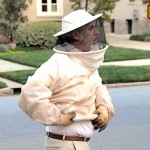
Tillman says both the Georgia Beekeepers Association (gabeekeeping.com) and MABA (metroatlantabeekeepers.org) maintain a list of keepers who will collect swarms. In fact, Tillman says there are quite a few beekeepers in VaHi – herself included – who will gladly come collect a swarm. You can check out Tillman’s blog at www.beekeeperlinda.com or email her at linda.tillman@gmail.com.
Where did the North Virginia Avenue bees end up and how are they doing? Lee says he gave them to a fellow beekeeper in Tucker. They’re doing fine, he says, and have even found a new purpose in life.
“My friend’s daughter is ill and can’t go out much,” Lee says. “She gets a lot of pleasure from having the bees in their backyard and knowing they’re happy and safe.”
VOICE says bee-utiful!